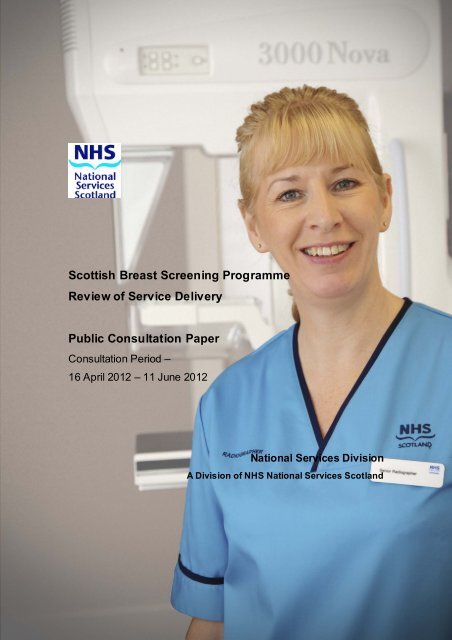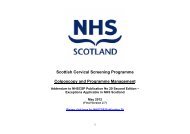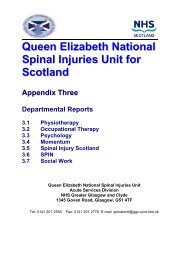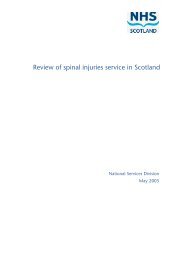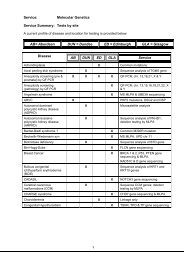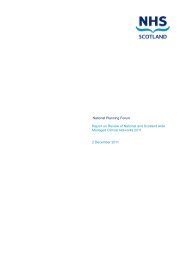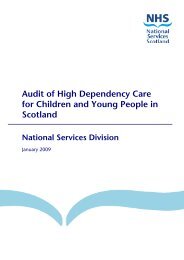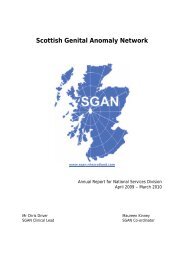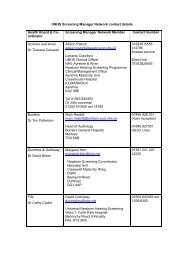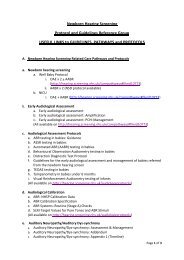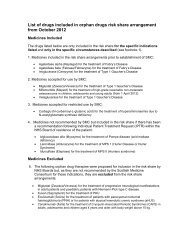Scottish Breast Screening Programme Review of Service Delivery ...
Scottish Breast Screening Programme Review of Service Delivery ...
Scottish Breast Screening Programme Review of Service Delivery ...
Create successful ePaper yourself
Turn your PDF publications into a flip-book with our unique Google optimized e-Paper software.
<strong>Scottish</strong> <strong>Breast</strong> <strong>Screening</strong> <strong>Programme</strong><strong>Review</strong> <strong>of</strong> <strong>Service</strong> <strong>Delivery</strong>Public Consultation PaperConsultation Period –16 April 2012 – 11 June 2012National <strong>Service</strong>s DivisionA Division <strong>of</strong> NHS National <strong>Service</strong>s Scotland1
The NHS Scotland National Planning Forum (NPF) has commissionedNational <strong>Service</strong>s Division (NSD), part <strong>of</strong> National <strong>Service</strong>s Scotland (NSS) toundertake a review <strong>of</strong> the breast screening service in Scotland. A <strong>Breast</strong><strong>Screening</strong> <strong>Review</strong> Group was established with a remit to look at differentoptions for delivering the breast screening service, and from this to identify thepreferred option for the service.As part <strong>of</strong> the review process we would like to get your views on the preferredoption, the details <strong>of</strong> which are outlined in this paper. Your comments will helpthe <strong>Breast</strong> <strong>Screening</strong> <strong>Review</strong> Group to develop its’ final co nclusions andrecommendations to the National Planning Forum.Although this paper sets out a preferred option, the <strong>Review</strong> Group willtake into account all comments and suggestions received.If you would like to give your comments you can do so in the following ways:• Electronic – go to www.breastscreeningconsultation.scot.nhs.ukand complete the online feedback questionnaire, or email yourcomments to NSS.<strong>Breast</strong>-screening-co nsultation@nhs.net• By post – please complete the feedback questionnaire issued with thisdocument and return it to Donna Hutchison, Area 062 National<strong>Service</strong>s Division, NSS Headquarters, 1 South Gyle Crescent,Edinburgh EH12 9EBAll comments need to be received by 11 th June 2012If you need more copies <strong>of</strong> the consultation paper or questionnaire,please phone (leaving your name and address) 0131 275 6267 or emailus at NSS.<strong>Breast</strong>-screening-consultation@nhs.net3
Introduction to the Consultation PaperThis paper describes the <strong>Review</strong> Group’s preferred option for delivering thebreast screening service in Scotland. A number <strong>of</strong> options were developed bythe <strong>Review</strong> Group. These options were then assessed using a formal OptionAppraisal process. As part <strong>of</strong> the options appraisal process stakeholders fromwithin NHS Scotland were also asked to provide their comments on theoptions available. This consultation paper outlines:1. Why and how we developed the options2. Description <strong>of</strong> the breast screening service in Scotland3. Description <strong>of</strong> the preferred option for service delivery4. What happens if the preferred option is accepted by the NationalPlanning Forum5. How people have been involved in the options appraisal6. Overview <strong>of</strong> the results <strong>of</strong> the options appraisalWhere can I find out more information?For more information about the Option Appraisal and the wider breastscreening review, please go to:http://www.nsd.scot.nhs.uk/services/screening/breastscreening/breastreview.htmlOverviewThe overarching aim <strong>of</strong> the <strong>Review</strong> is to identify the option for service deliverythat will maximise the clinical and cost effectiveness <strong>of</strong> the breast screeningprogramme in Scotland ( to ensure resources - staff, budget and buildingsareused as effectively and efficiently as possible).In addition the service delivery model needs to ensure that the service issustainable in terms <strong>of</strong> staffing, and meets the needs <strong>of</strong> women in Scotlandwho use the service. This work is aligned with the <strong>Scottish</strong> GovernmentDetect Cancer Early Initiative which aims to increase the early detection <strong>of</strong>cancer.Women receiving a diagnosis <strong>of</strong> breast cancer are referred by the breastscreening centre to the local symptomatic breast service for treatment.Table 1 below outlines the main differences between the current service andthe preferred option, plus the expected benefits <strong>of</strong> this change. The proposedoption covers all the six centres that form the <strong>Scottish</strong> <strong>Breast</strong> <strong>Screening</strong><strong>Programme</strong>.Although this paper sets out a preferred option, the <strong>Review</strong> Group will takeinto account all comments and suggestions received.The preferred option is: Retain the six centre service model but combinedwith local symptomatic breast services.4
Table 1: Summary <strong>of</strong> main differences between the current <strong>Service</strong> and the proposed change (preferred option)Current <strong>Service</strong> Proposed <strong>Service</strong> Main Benefits <strong>of</strong> Proposal Consultation StatusThere are currently 6 breastscreening centres in Scotland,supported by 19 mobile units.The 6 breast screening centresare located in:There would still be 6 breastscreening centres in Scotland,supported by a fleet <strong>of</strong> mobile units.The 4 breast screening centres thatA survey <strong>of</strong> all women wasundertaken during August 2011to assess women’s preferencesfor delivery <strong>of</strong> the breastPublic Consultation16 th April to 11 th June2012.- Glasgoware currently located separately screening service. This- Edinburghwould be combined with the concluded that the majority <strong>of</strong>- Irvinesymptomatic service within the NHS women stating a preference did- AberdeenBoard in which they are currently not mind whether the screening- Dundeesituated.units were situated in a hospital- Invernessor community setting.Two <strong>of</strong> the breast screeningcentres are currently combinedwith the local symptomaticbreast service (NinewellsHospital, Dundee andRaigmore Hospital, Inverness).The Pros and Cons identifiedfor this option are given inTable 2 below.Women are screened both atthe static centres and on thefleet <strong>of</strong> mobiles providing localscreening to women acrossScotland Approximately 80% <strong>of</strong>screening takes place on themobile units.5
Table 2: Six breast screening centres combined with local symptomatic breast servicesPROSCONS<strong>Service</strong> Users• Increased job satisfaction for staff• Job variety which would be more attractive to potential recruits• More streamlined/joined up working between screening andsymptomatic service• Continuity <strong>of</strong> care for women• Women appreciate having access to a breast centre for screening/symptomatic – as it is seen as a centre <strong>of</strong> excellence• Separate waiting rooms for patients maintains the separation betweensymptomatic and screening patients• Better experience for women referred for treatment as continuity <strong>of</strong> staffStaff• Improved training opportunities for staff• Provides variation – and therefore better career progression forradiographers• Creates a more cohesive breast team through multi disciplinaryapproach• Staff are more included within general NHS• There would be no travelling between centres for staff• There was greater opportunity for role extensionOrganisation• Better utilisation <strong>of</strong> equipment• Better utilisation <strong>of</strong> staff and expertise which would be <strong>of</strong> benefit toworkforce planning and the service.<strong>Service</strong> Users• Mixing symptomatic and screening patients is currently notregarded as best practice• Women may not prepared to go to hospital for screeningappointmentStaff• There would need to be a change in terms and conditionsfor some staff• Possibility <strong>of</strong> reduced job satisfaction• Resistance <strong>of</strong> staff to change• Staff retention following merging• Mixed staffing may cause logistical problems• Staff configuration problems/changes – access forengineersOrganisation• Premises with sufficient space may not be available• Lack <strong>of</strong> capital funding to build or extend existing premises• Potential for the symptomatic service to be prioritisedwhen resources issues e.g. staff shortage• Can be complex to manage• For larger centres this may be logistically difficult• Potential issues if different IT systems are in place forsymptomatic/screening• Converting to a more medical environment• Utilisation <strong>of</strong> symptomatic sites may be difficult6
• Consistency <strong>of</strong> standards - potential to bring the symptomatic service inline with the SBSP performance and quality assurance standards• Minimal impact on uptake• Tried and tested in 2 screening centres• Potential to improve the symptomatic and breast screening services bycloser working co-operation• Better recruitment and retention <strong>of</strong> radiology staff• Equality <strong>of</strong> service screening/symptomatic• Retaining skills & staff within one area• More collaboration with cancer services• Cost sharing - efficiencies could be achieved by sharing equipment andexpertise• Opportunity to develop breast diagnosis in highly specialist servicecould sa ve money in the long term• Creates breast centres <strong>of</strong> excellence• Any option that keeps mobile unit is good for service• This option is already in place in 2 centres at present• Despite hospital setting for screening appearing to be against the ethosfor well women, there has been no reduction in uptake within Highland,following combination.• Easier to get films for symptomatic patients if on same site• Easier to collect data – e.g. access to IT systems• Insufficient capacity for all West Of Scotland screeningpopulation• Women in the West <strong>of</strong> Scotland with a screened detectedbreast cancer are referred to a number <strong>of</strong> symptomaticbreast services• Boards LDP(Local Development Plans) may decidescreening not a priority• Potential for smaller sites – considered to be inferior• Multiple symptomatic sites with the potential for one tobecome a 2 nd rate site• The administration element <strong>of</strong> screening would have to beseparate from symptomatic• There may be confusion over who was in charge• At present funding is ring fenced for symptomatic &screening individually, therefore it could be challenging tomanage.• Inviting ladies to a cancer centre may reduce uptake• Physics - access to equipment for physics checks couldbe more challenging• Cost <strong>of</strong> expansion• Large services would be difficult to manage with 2 sets <strong>of</strong>staff• Risk that national funding for breast screening is absorbedwithin overall breast services budget7
1. Why and how we developed the optionsThis section outlines:1.1 The objectives <strong>of</strong> the <strong>Scottish</strong> <strong>Breast</strong> <strong>Programme</strong>1.2 Why the way the <strong>Scottish</strong> <strong>Breast</strong> <strong>Screening</strong> <strong>Programme</strong> is deliveredneeds to change1.3 What we aim to achieve1.4 What has the review achieved so far1.5 When a decision will be made1.1 The <strong>Scottish</strong> <strong>Breast</strong> <strong>Screening</strong> <strong>Programme</strong> objectivesThe <strong>Scottish</strong> <strong>Breast</strong> <strong>Screening</strong> <strong>Programme</strong> objectives are to:- Reduce mortality from breast cancer- Invite all women aged 50 -70 to attend for breast screening for earlysigns <strong>of</strong> breast cancer every 3 years;- Ensure clinically and cost effective screening <strong>of</strong> all women who take upthe invitation for screening;- Adhere to UK National and Healthcare Information Scotland (HIS)quality standards for breast screening;- Undertake further investigations where an abnormality is present, andensure onward referral for treatment if required.1.2 Why the way the <strong>Scottish</strong> <strong>Breast</strong> <strong>Screening</strong> <strong>Programme</strong> is deliveredneeds to change?The <strong>Scottish</strong> <strong>Breast</strong> <strong>Screening</strong> <strong>Programme</strong> (SBSP) was set up over 22 yearsago, and although the programme has undergone significant developmentsover the years, the way the service is delivered has never been reviewed.It was agreed by the NHS Scotland National Planning Forum (NPF) that anational review <strong>of</strong> the service was necessary to ensure that it can adapt tomeet current and future challenges.Ensuring Sustainability – <strong>Service</strong>A key challenge for the programme is the requirement to review thedistribution <strong>of</strong> breast screening resources across Scotland to ensure thatresources are matched to need. The way the SBSP is organised anddeveloped in the future should guarantee sustainability, clinical and costeffectiveness.In particular it should meet the needs <strong>of</strong> the women it serves as encapsulatedin the NHS Scotland Quality Strategy which has at its heart the six domains <strong>of</strong>quality i.e. Safe, Effective, Person Centred, Equitable, Efficient, and Timely.8
Ensuring Sustainability – StaffingAnother key challenge is to ensure the service operates with enough staff toenable women to be called for screening and receive notification <strong>of</strong> results ina timely fashion. In recent years, some centres have experienced difficulty inrecruiting appropriately trained radiography and radiology staff. In addition anumber <strong>of</strong> staff within the breast screening service will be retiring over thenext few years.Developments in technologyDevelopments in technology have required the SBSP to undertake earlyplanning for modernising working practices through the introduction <strong>of</strong> digitalmammography where digital images rather than the traditional analogue filmimages are used.The SBSP has an ageing pr<strong>of</strong>ile <strong>of</strong> mammography units, a number <strong>of</strong> whichmay require replacing sooner rather than later. Sourcing <strong>of</strong> film chemicals,engineering support, replacement parts and new analogue equipment willbecome increasingly difficult as the current analogue technology becomesobsolete.The introduction <strong>of</strong> digital mammography will incur significant cost at a time <strong>of</strong>financial constraint, and ways <strong>of</strong> maximising the efficient use <strong>of</strong> thistechnology will need to be considered. The overall annual funding for thescreening service will not be affected; however, there will be a need to makesubstantial efficiency savings to meet the additional running costs <strong>of</strong> digitalmammography.1.3 What do we aim to achieve?The key objective <strong>of</strong> the review is to ‘set out the implications <strong>of</strong> newmodels <strong>of</strong> service to optimise both clinical and cost effectiveness <strong>of</strong> thebreast screening programme’.The <strong>Review</strong> recommendations will take into account the need to ensure that are-designed service will not adversely impact on uptake <strong>of</strong> screening and thatthe long term operational costs are within the current budget.The <strong>Review</strong> recommendations will also take into consideration the fact thatthe SBSP must co ntinue to meet national performance standards, and that itis Safe, Effective, Person Centred, Equitable, Efficient, and Timely.9
1.4 When will a decision be made?Following the consultation period the final co nclusions and recommendationswill be agreed by the <strong>Review</strong> Group. The outcome <strong>of</strong> the <strong>Review</strong> will bereported initially to the National Planning Forum (NPF) and the NHS ScotlandBoard Chief Executives Group. The recommendations from these groups willthen be considered by <strong>Scottish</strong> Government Health and Social CareDirectorates.2. Description <strong>of</strong> the current <strong>Breast</strong> <strong>Screening</strong> <strong>Service</strong> in ScotlandIn Scotland, women aged 50-70 are invited for a routine screen every threeyears. Approximately 76% <strong>of</strong> those invited attend for screening. Women whohave abnormal results will be called back to the screening centre forassessment which will include further mammograms, ultrasound examination,and if necessary a biopsy to enable a tissue diagnosis to be made.National <strong>Service</strong>s Division currently commissions the <strong>Scottish</strong> <strong>Breast</strong><strong>Screening</strong> <strong>Programme</strong> (SBSP) from the 6 host NHS boards:- NHS Ayrshire and Arran- NHS Grampian- NHS Greater Glasgow and Clyde- NHS Highland- NHS Lothian- NHS TaysideCurrently NSD has central responsibility for the provision <strong>of</strong> medical physicssupport for the whole screening programme, the mobile units and the breastscreening IT system.The 6 breast screening centres in Scotland are supported by 19 mobile units,plus two spare mobiles for use during annual maintenance checks. Thebreast screening centres (BSC) are as follows:- West <strong>of</strong> Scotland BSC, Nelson Mandela Place, Glasgow- South East Scotland BSC, Ardmillan Terrace, Edinburgh- East <strong>of</strong> Scotland BSC, Ninewells Hospital, Dundee- South West Scotland BSC,Ayrshire Central Hospital, Irvine- North <strong>of</strong> Scotland BSC, Raigmore Hospital, Inverness- North East Scotland BSC, Aberdeen Royal Hospital, AberdeenThe breast screening centres in Dundee and Inverness are currentlycombined with the local symptomatic breast service.The fleet <strong>of</strong> 19 mobiles provide screening locally to women across Scotlande.g. in supermarket car parks and approximately 80% <strong>of</strong> women are screenedon these units.10
Training for those employed within the service is undertaken in-house by the<strong>Scottish</strong> Mammography Training Centre (SMEC). The training centre is basedat Nelson Mandela Place in Glasgow, with a satellite training centre based atArdmillan Terrace, Edinburgh.Key Facts: <strong>Scottish</strong> <strong>Breast</strong> <strong>Screening</strong> <strong>Programme</strong> – 2009/10• Over 160,000 women screened (excluding self referrals)• Uptake <strong>of</strong> screening approximately 75%• Approximately 1,400 breast cancers detected• The service costs around £14 million per year3. Description <strong>of</strong> the preferred option for service deliveryOption DevelopmentAt the beginning <strong>of</strong> the process an independent <strong>Breast</strong> <strong>Screening</strong> <strong>Review</strong>Group was established to agree appropriate evidence, review the evidence,complete an options appraisal and agree a final report to be submitted to theNational Planning Forum in December 2012. A <strong>Review</strong> Support Team wascharged with collecting the evidence and assisting with the process. Fullmembership <strong>of</strong> these groups is shown in Appendix 1.The <strong>Review</strong> Group developed an initial long list <strong>of</strong> options for service delivery;each option was assessed using the SFA (Suitability, Feasibility andAcceptability) method to determine whether the option should be takenforward to the shortlist. The <strong>Review</strong> Group also agreed the criteria (what theoptions should be assessed against), the weighting (how important the criteriawas) and the scoring methodology (how it would be marked).Stakeholders (screening staff and others with a direct involved with thescreening programme) were asked for their views on the short listed optionsat an event held in November. Stakeholders were asked to identify the prosand cons <strong>of</strong> each <strong>of</strong> the short listed options. The results <strong>of</strong> the stakeholderday were used by the <strong>Review</strong> Group when evaluating the options.Six options were appraised and Option 2 had the highest score - Six centremodel but combined with host NHS Board symptomatic breast serviceWith this option the current configuration <strong>of</strong> six centres and 19 mobile units isretained. However, the 4 centres that are not currently combined with thesymptomatic service may be co-located with the local symptomatic breastservice(s).11
The 4 screening centres are as follows:• North East <strong>of</strong> Scotland - Aberdeen Royal Hospital, Aberdeen• South East <strong>of</strong> Scotland - Ardmillan Terrace, Edinburgh• South West <strong>of</strong> Scotland - Ayrshire Central Hospital, Irvine• West <strong>of</strong> Scotland - Nelson Mandela Place, GlasgowShould the preferred option be taken forward these centres would co-locatewith a hospital or hospitals within their area that provides symptomatic breastcare.A combined service currently operates within two <strong>of</strong> the breast screeningservices (Dundee and Inverness); therefore, these two centres would not bedirectly affected by the change.4. What does this mean for me?Dependent on the Health Board you reside in Table 3 defines what impact theproposal may have on you.12
Table 3 - What does this mean for me?<strong>Breast</strong><strong>Screening</strong>CentreNorthScotland –InvernessNorth EastScotland –AberdeenNHS BoardscoveredHighland(excludingArgyll andBute),WesternIsles,Grampian(Forres areaonly)Grampian,Orkney andShetlandCurrent <strong>Service</strong>Combined - <strong>Screening</strong> andSymptomatic in onebuilding within RaigmoreHospital, Inverness.Outreach via Mobile Units.Not combined – <strong>Screening</strong>service and symptomaticare both within AberdeenRoyal Infirmary withinseparate areas.Outreach via Mobile Units.<strong>Breast</strong><strong>Screening</strong>Waiting AreaTogetherinitially andthenseparated toscreening andsymptomatic<strong>Screening</strong>onlyPossible Impact <strong>of</strong> Proposed Change<strong>Breast</strong><strong>Screening</strong>Waiting AreaCombined – <strong>Screening</strong> and No ChangeSymptomatic in one area withinRaigmore Hospital.Outreach via Mobile units orwithin more local health facilities.Combined – <strong>Screening</strong> andSymptomatic in one area withinAberdeen Royal Infirmary.Outreach via Mobile units orwithin more local health facilities.May beShared13
WestScotland –GlasgowSouth WestScotland –IrvineGreaterGlasgow andClyde,Lanarkshire,part <strong>of</strong> ForthValley (Killin,Stirling,Dollar andAlloa), part <strong>of</strong>Highland(Port Appin,Oban, Islay,Tarbet,Campbeltownand Bute)Ayrshire andArran,Dumfries andGallowayNot combined – <strong>Screening</strong>service is based withinNelson Mandela Place,Glasgow and Symptomaticis provided within hospitalsthroughout NHS GreaterGlasgow & Clyde and theother NHS Boards coveredby West Scotland <strong>Breast</strong><strong>Screening</strong> <strong>Service</strong>.Outreach via Mobile Units.Not combined – <strong>Screening</strong>service is provided withinAyrshire Central Hospitaland Symptomatic isprovided within hospitalsthroughout NHS Ayrshireand Arran and NHSDumfries and Gallowayboth <strong>of</strong> whom are coveredby South West Scotland<strong>Breast</strong> <strong>Screening</strong> <strong>Service</strong>.Outreach via Mobile Units.<strong>Screening</strong>only<strong>Screening</strong>onlyCombined – <strong>Screening</strong> andSymptomatic in one area withinone or more screening centre orhospital(s).Outreach via Mobile units orwithin more local health facilities.Combined – <strong>Screening</strong> andSymptomatic in one area withinone or more hospital(s).Outreach via Mobile units orwithin more local health facilities.May beSharedMay beShared14
EastScotland –DundeeSouth EastScotland -EdinburghTayside, Fife(coveringNorth Eastinc Cupar,East Neukand StAndrews)Lothian,Borders,Forth Valley(part <strong>of</strong> incFalkirk,GrangemouthandSlamannan)and also part<strong>of</strong> Fife (incMarkinch,Dunfermline,Glenrothesand Leven)Combined - <strong>Screening</strong> andSymptomatic in one areawithin Ninewells Hospital,Dundee.Symptomatic is alsoprovided within hospitalsthroughout NHS Taysideand NHS Fife both <strong>of</strong> whomare covered by EastScotland <strong>Breast</strong> <strong>Screening</strong><strong>Service</strong>.Outreach via Mobile Units.Not combined – <strong>Screening</strong>service is based withinArdmillan Terrace,Edinburgh andSymptomatic is alsoprovided within hospitalsthroughout NHS Lothian,NHS Borders, NHS ForthValley and NHS Fifecovered by the South EastScotland <strong>Breast</strong> <strong>Screening</strong><strong>Service</strong>.Outreach via Mobile Units.Separatewaiting areas<strong>Screening</strong>OnlyCombined – <strong>Screening</strong> andSymptomatic in one area withinNinewells Hospital, Dundee.Outreach via Mobile units orwithin more local health facilities.Combined – <strong>Screening</strong> andSymptomatic in one area withinone or more hospital(s).Outreach via Mobile units orwithin more local health facilitiesMay beSharedMay beShared15
5. What will happen if the preferred option is accepted by NationalPlanning Forum?NHS Boards, breast screening and symptomatic services are currentlyundertaking an evaluation <strong>of</strong> the preferred option, the results <strong>of</strong> the publicconsultation and the results <strong>of</strong> the work with NHS Boards will shape how thisproposal is developed.If the proposal is accepted by the National Planning Forum, this will besubmitted for approval to the NHS Board Chief Executives Group, and thentaken forward to the Cabinet Secretary for Health, Wellbeing and Cities.Detailed planning would then be required with all relevant stakeholders, inparticular the NHS Boards, breast screening services, symptomatic services.6. How People have been involved in the Options AppraisalAdvice and guidance on the requirements for public involvement andconsultation has been provided throughout the review process by the <strong>Scottish</strong>Health Council (SHC). The <strong>Scottish</strong> Health Council guidance has taken intoaccount CEL 4 (2010) , ‘Informing, Engaging and Consulting People inDeveloping Health and Community Care <strong>Service</strong>s’, which advises on the level<strong>of</strong> public consultation and assessment activity required for a review <strong>of</strong> thisscale.To ensure all stakeholders were given the opportunity to contribute to theprocess, and provide information to the review, a survey <strong>of</strong> women’spreferences for the delivery <strong>of</strong> the breast screening service was launched bythe Cabinet Secretary, alongside the launch <strong>of</strong> the <strong>Scottish</strong> Government’sDetect Cancer Early Initiative on 31 July 2011. In addition a survey wasissued to all staff to gain their opinion on the best way forward and surveyswere issued to Radiographers and Radiologists to ascertain their views inrelation to workforce choices. The surveys ran from 1 to 31 August 2011.Following feedback from staff, individual site visits were also conducted toascertain views <strong>of</strong> staff.To ensure that the <strong>Review</strong> is conducted in adherence with equalitieslegislation an Equality and Diversity Impact Assessment was carried out onthe current breast screening service, this process will be repeated on thepreferred option for service configuration. In addition, a Health InequalitiesImpact Assessment (HIIA) workshop was held on 9 September 2011 to seekthe views <strong>of</strong> minority interest groups in relation to the service and theequalities challenges which exist within provision <strong>of</strong> a service like breastscreening.The full results <strong>of</strong> the surveys and the output from the HIIA workshop areavailable in the report entitled Results <strong>of</strong> Initial Consultation which is availableat the following web page:-http://www.nsd.scot.nhs.uk/services/screening/breastscreening/breastreview.html16
The <strong>Review</strong> Group membership includes 2 patient/public representatives.However, it was agreed by the <strong>Review</strong> Group, following advice from the<strong>Scottish</strong> Health Council 1 (SHC) that due to the potential impact for women inScotland additional appropriate representation should be made during thescoring exercise. Therefore representation was sought from patient publicinvolvement groups within Scotland for independent public representatives toattend the options appraisal and score the options. 10 representativesattended an introductory workshop at which an outline <strong>of</strong> the <strong>Review</strong> wasprovided; 7 representatives attended the options appraisal day to score theoptions.7. Overview <strong>of</strong> the results <strong>of</strong> the options appraisalTable 4 below provides an overview <strong>of</strong> the six short listed options and theresult <strong>of</strong> the scoring exercise.1 (1) The <strong>Scottish</strong> Health Council was established by the <strong>Scottish</strong> Executive in April2005 to promote Patient Focus and Public Involvement in the NHS in Scotland. Themain aim <strong>of</strong> the SHC is to ensure that the NHS works in partnership with patients,carers and the public in the planning and delivery <strong>of</strong> NHS services. More informationcan be found at http://www.scottishhealthcouncil.org/home.aspx17
Table 4: Summary <strong>of</strong> Scored OptionsBenefit Score Ranking Model Description1 Ranked 1 st – Preferred Option Six centre model butcombined with host NHSBoard symptomaticbreast service2 Ranked 2 nd Six centre model butwith substantial serviceefficiencies3 Ranked 3 rd Six centre model butwith fewer mobileunits/sites visited (withor without co-location)4 Ranked 4 th Three centre model(with or without colocation)5 Ranked 5 th Centralised call/recall<strong>of</strong>fice with local centresforscreening/assessment6 Ranked 6 th Three centre model(with or without colocation)Retain the current configuration i.e. six centres, 19 mobiles,but combined with the symptomatic service.Retain the current configuration i.e. six centres in currentformat, with 19 mobile screening units (one is a doublemobile) visiting the same number <strong>of</strong> sites, but with substantialefficiency savingsRetain the six centre model but with substantial efficiencysavings, including a reduced number <strong>of</strong> mobiles in service i.e.reduce the number <strong>of</strong> sites visited. This could include greateruse <strong>of</strong> semi-static units and static outreach sites such as localhospitals for routine mammographyThree regional centres in line with the regionalplanning/ca ncer network structure, retaining the currentnumber <strong>of</strong> mobiles i.e. retain the current geographicalcoverage for routine screening.One national call/recall facility for the SBSP with 6 or lesslocal static centres, and a fleet <strong>of</strong> mobiles/semi static/staticoutreach centres delivering routine breast screening acrossScotland. This would cover invitations and changes toappointments only.Three regional centres in line with the regional planningstructure, reducing the number <strong>of</strong> mobiles i.e. reduce thenumber <strong>of</strong> sites visited. This could include greater use <strong>of</strong>semi-static units and static outreach sites such as localhospitals for routine mammography.18
<strong>Breast</strong> <strong>Screening</strong> <strong>Review</strong> 2011/12<strong>Review</strong> Group - Membership ListAPPENDIX 1Chair Mr Calum Campbell Chief Executive NHSBordersChief OperatingOfficerDr Pauline StrachanNHS GrampianMedical Director Dr Bob Masterton NHS Ayshire & ArranDirector <strong>of</strong> Planning Mr Peter Williamson NHS TaysideDirector <strong>of</strong> PublicHealthDr Eric BaijalNHS Borders<strong>Screening</strong> Coordinator Dr Emilia CrightonDr Rani BalendraNHS Greater Glasgowand ClydeNHS Forth ValleyAssociate Director <strong>of</strong>FinanceMs Lynne HollisNHS LothianIndependent Expert Dr Rosemary Fox <strong>Breast</strong> Test WalesSBSP Clinical Director Dr Peter Hendry North <strong>of</strong> Scotland BSCSBSP SuperintendentRadiographer<strong>Scottish</strong>MammographyEducation CentreSBSP <strong>Service</strong>ManagerRegional CancerGroupsSBSP QualityAssurance ReferenceCommitteePatient/PublicrepresentationMs Kathy HallidayMs Ann MumbyTraining CoordinatorMs Debbie ArchibaldMr Peter GentMs Kate MacDonaldMs Evelyn ThomsonDr Hilary DobsonAlison WalkerKate CurtisSE Scotland BSCEast <strong>of</strong> Scotland BSCNoSCANSCANWoSCANNHS GGC19
<strong>Review</strong> Support Team - Membership ListROLE NAME ORGANIS ATIONChair David Steel NHS NSDFinancePeter CroanGordon KirkpatrickNHS NSDMedical Advisor Mike Winter NHS NSDAdvisor Carol Colquhoun NHS NSD<strong>Programme</strong> Manager Karen Butler NHS NSD<strong>Programme</strong> Support Marie Richmond NHS NSDCancer PerformanceSupport TeamDavid Linden<strong>Scottish</strong> GovernmentEquality and Diversity Louise MacLennan NHS NSS<strong>Scottish</strong> HealthCouncil (SHC)CommunicationsAdvisorEmma AshmanGeorge CuthillJohn MacEachenSHCSHCNHS NSS<strong>Scottish</strong> Government Cheryl Paris <strong>Scottish</strong> GovernmentNational NetworkManagerMedical PhysicsJim CannonClaire DarraghKath Sch<strong>of</strong>ieldManaged DiagnosticImaging ClinicalNetwork (MDICN)NHS NSSSPR Kevin Dunbar NHS TaysideHealth Economist Nils Michael <strong>Scottish</strong> Government21


